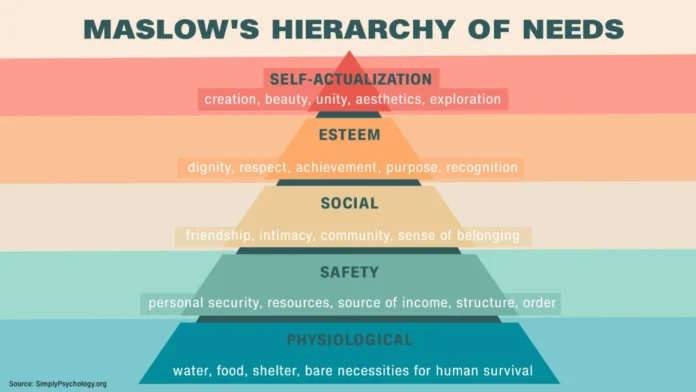In psychology, there are many models that simplify some ideas of the science. One of the most famous is Maslow’s Pyramid. Probably everyone has heard of it at least once in their life. What does this conceptual structure represent?
Maslow and His Theory of Needs
Named after the psychologist Abraham Maslow, this model addresses what needs people experience in their lives and how these needs influence their behavior. Understanding these questions has practical implications, as it helps to better understand the motives driving people in their purchasing decisions and family budgeting. From an economic perspective, the fulfillment of needs is the purpose of any economic activity.
Maslow detailed his theory of needs in the book “Motivation and Personality,” published in 1954. The pyramid provides a convenient way to explain one of the core principles of his theory: the existence of a hierarchy of needs.
Maslow observed that different people have different needs. These include food, water, love, housing, respect, and more. A working-class individual might not be interested in attending theaters and exhibitions, whereas hereditary aristocrats might consider these activities essential. Why do people’s needs differ so greatly?
Maslow suggested that all needs can be arranged in a hierarchy, where a person will not focus on higher-level needs until the lower-level needs are satisfied. For example, if a beggar cannot find a piece of bread, they are unlikely to be concerned about their appearance or social status. Conversely, many cultural figures throughout history came from elite social classes, such as the nobility. They did not have problems with food, social status, or prestige from birth, so they pursued the higher human need of self-actualization.
Maslow’s Hierarchy of Needs
In literature, there are two types of Maslow’s pyramids. One contains 5 levels of needs, while the other has 7.
Maslow initially identified 5 levels of needs. At the bottom are physiological needs related to the biological essence of humans, such as food, water, sleep, etc.
The second level includes safety needs. People want to feel secure, so this includes the desire for stability and good health.
Next are social needs, which involve the desire to interact with others and form social connections. This includes communication, friendship, and love.
However, people also strive to attain a higher status within society. These desires are categorized as esteem needs. This category includes ambitions for career advancement, demonstrating prosperity, and possessing so-called “social markers” (expensive phones, watches, cars, dining at fine restaurants, vacationing at elite resorts, etc.).
Finally, at the top of the pyramid are spiritual needs: self-development, knowledge, self-awareness, seeking answers to existential questions (such as the meaning of life and the existence of God), and so on.
In the 7-Level Pyramid, the top level (spiritual needs) is divided into 3 separate groups:
- Creative needs (knowledge, exploration, creation)
- Aesthetic needs (harmony, beauty, perfection)
- Spiritual needs (growth, self-identification, etc.)
Is This Concept Valid?
At first glance, there are many examples supporting the validity of Maslow’s pyramid. It seems that the more successful a person is, the more interested they are in self-development, and the less they care about mundane pleasures.
However, there are also counterexamples. For instance, Vincent Van Gogh was poor throughout his life but sought self-actualization and created about 2,000 paintings. Ordinary people who join monasteries fulfill their spiritual needs, often without being wealthy or experiencing the joy of owning prestigious, status-symbol items.
On the other hand, in recent decades, the world’s wealth has increased, and hunger is no longer a major issue for many countries. As a result, we see an obesity epidemic in developed nations. People who do not lack food continue to consume it beyond necessity.
Alternative theories of needs exist. For example, it is evident that needs depend on mental development, which is partly determined by nature. People with high IQs are more likely to seek knowledge and explore the world, even if they lack money for food. Meanwhile, people with low IQs, even if wealthy, often do not read books. There is also a dependency of needs on age. Biologically, the opposite sex interests people much more in youth than in old age, which is related to hormone levels in the blood, not Maslow’s pyramid.
Psychology also has alternative theories of needs, such as Clayton Alderfer’s theory. He identified three groups of needs:
- Existence needs (physiological needs)
- Relatedness needs (social needs)
- Growth needs (spiritual needs)
In his hierarchy, movement is possible not only from the bottom up but also from the top down.
